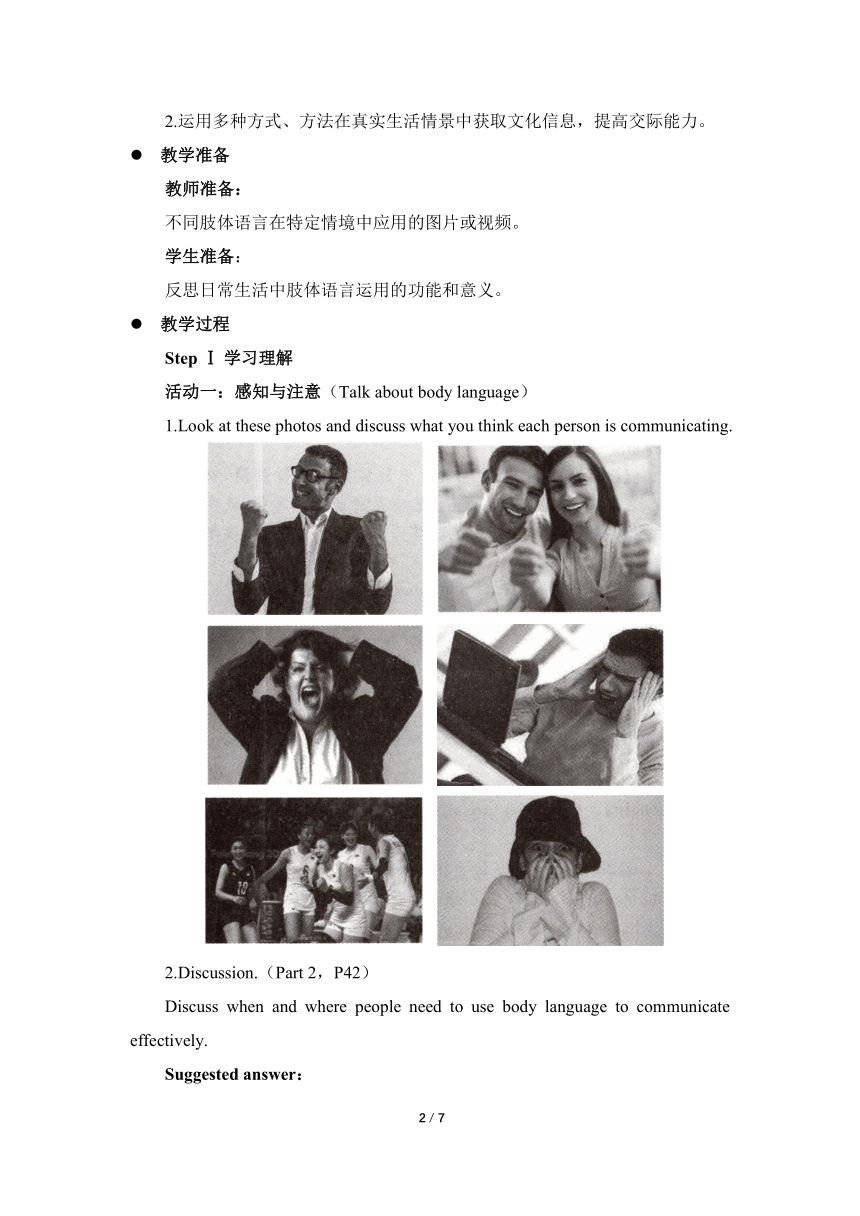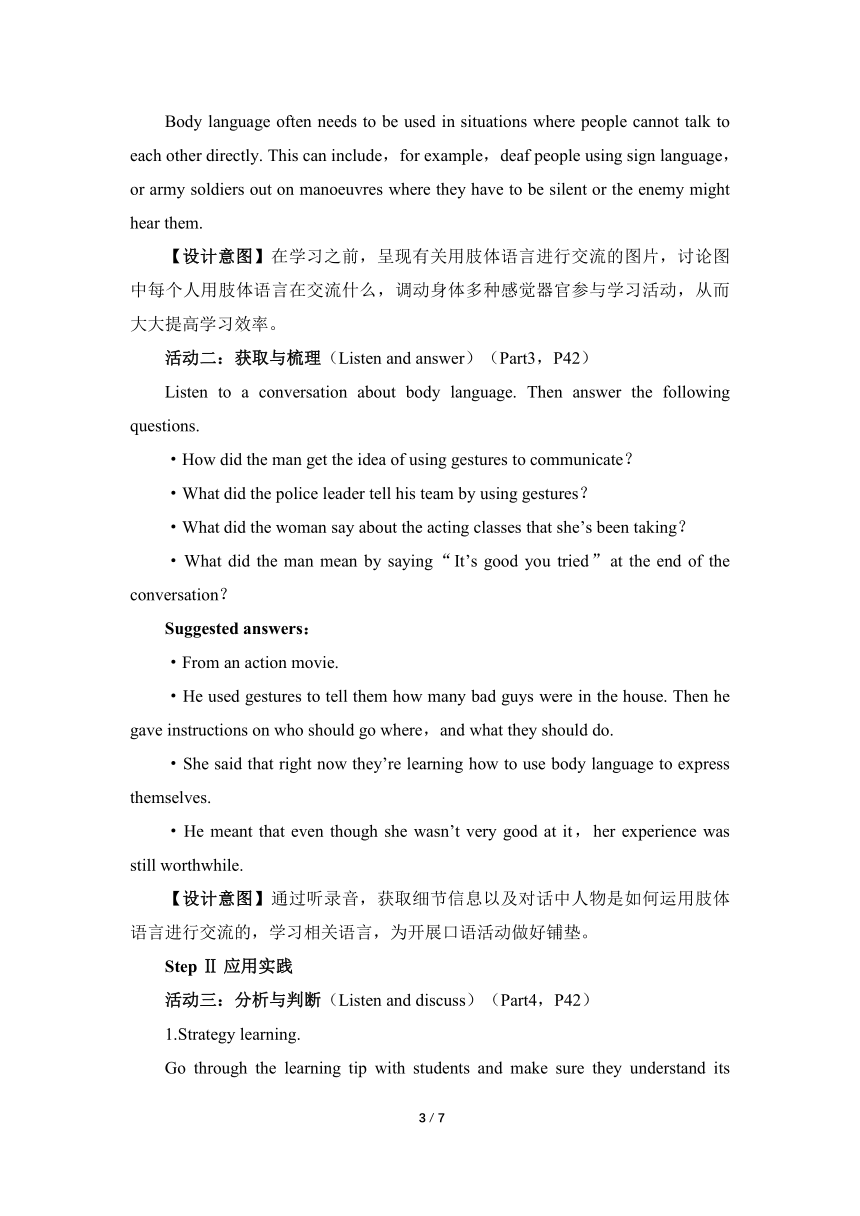人教版(2019)选择性必修 第一册Unit 4 Body Language Using Language(1) 名师教学设计
文档属性
| 名称 | 人教版(2019)选择性必修 第一册Unit 4 Body Language Using Language(1) 名师教学设计 |  | |
| 格式 | docx | ||
| 文件大小 | 1.7MB | ||
| 资源类型 | 教案 | ||
| 版本资源 | 人教版(2019) | ||
| 科目 | 英语 | ||
| 更新时间 | 2023-03-11 20:45:38 | ||
图片预览



文档简介
Unit4 Using Language(1) 名师教学设计
课时内容
Explore body language
主题语境:人与社会
主题群:社会服务与人际沟通
子主题:良好的人际关系与社会交往
语篇类型:听力、文本、图片
文本分析:
[what]本节课为听说课,学习语篇为一段谈论肢体语言的录音。文本设置是首先看图讨论:你认为图中每个人在交流什么?然后思考人们在何时何地需要用肢体语言来进行有效交流?接着听对话,回答四个问题。再次听对话,判断对话中的细节信息。最后完成情景表演:尝试用肢体语言进行交流。
[Why]提高交流技巧和使用肢体语言进行沟通的能力。
[How]将英语语用目标和本单元的主题语境结合起来,设置听、说活动,让学生在主题语境的探索中提高英语运用能力,深入对主题的探究。
课时目标
1.能够获取录音对话中人物对肢体语言的有效运用,认识到肢体语言的重要性。
2.能够读懂肢体语言,并根据实际情况巧妙地运用肢体语言来表达自己的想法和情感。
3.能够运用多种方式、方法在真实生活情景中获取文化信息,提高交际能力。
重点难点
重点:
获取录音对话中人物对肢体语言的有效运用,认识到肢体语言的重要性等信息。
难点:
1.读懂肢体语言,并根据实际情况巧妙地运用肢体语言来表达自己的想法和情感。
2.运用多种方式、方法在真实生活情景中获取文化信息,提高交际能力。
教学准备
教师准备:
不同肢体语言在特定情境中应用的图片或视频。
学生准备:
反思日常生活中肢体语言运用的功能和意义。
教学过程
Step Ⅰ 学习理解
活动一:感知与注意(Talk about body language)
1.Look at these photos and discuss what you think each person is communicating.
2.Discussion.(Part 2,P42)
Discuss when and where people need to use body language to communicate effectively.
Suggested answer:
Body language often needs to be used in situations where people cannot talk to each other directly. This can include,for example,deaf people using sign language,or army soldiers out on manoeuvres where they have to be silent or the enemy might hear them.
【设计意图】在学习之前,呈现有关用肢体语言进行交流的图片,讨论图中每个人用肢体语言在交流什么,调动身体多种感觉器官参与学习活动,从而大大提高学习效率。
活动二:获取与梳理(Listen and answer)(Part3,P42)
Listen to a conversation about body language. Then answer the following questions.
·How did the man get the idea of using gestures to communicate?
·What did the police leader tell his team by using gestures?
·What did the woman say about the acting classes that she’s been taking?
·What did the man mean by saying“It’s good you tried”at the end of the conversation?
Suggested answers:
·From an action movie.
·He used gestures to tell them how many bad guys were in the house. Then he gave instructions on who should go where,and what they should do.
·She said that right now they’re learning how to use body language to express themselves.
·He meant that even though she wasn’t very good at it,her experience was still worthwhile.
【设计意图】通过听录音,获取细节信息以及对话中人物是如何运用肢体语言进行交流的,学习相关语言,为开展口语活动做好铺垫。
Step Ⅱ 应用实践
活动三:分析与判断(Listen and discuss)(Part4,P42)
1.Strategy learning.
Go through the learning tip with students and make sure they understand its meaning.
2.Listen to the conversation again. Are the following statements correct inferences from the conversation
① The two speakers are married. ② Making too many gestures in communication is not polite. ③ The police team were probably successful in catching the criminals. ④ Both speakers think body language is useful. ⑤ The woman is not very confident about her silent acting ability.
Suggested answers:
① No ② No ③ Yes ④ Yes ⑤ Yes
【设计意图】通过理解学习策略,然后将策略应用到听力活动中,帮助提高听力效果。学习策略的掌握需要一个长期的大量的练习过程,建议老师在教学中收集相关材料,加强对学习策略的练习,直到自动化。
活动四:描述与阐释(Learn and communicate)(Part 5,P42)
1.Language learning.
Ask students to try to read the following structures about asking for and giving clarification over and over again until they can speak fluently.
Asking for and giving clarification What did you mean by... In other words... So you mean... What I meant was... So did that mean... What I was trying to say was... What I don’t quite understand is... Does that make sense Could you explain... Is that clear Could you give me an example I can tell that...
2.Divide students into groups of four. One of them is the performer,and the others are observers.
3.The performer writes down a situation and some messages to convey through body language.
4.The performer acts out the scene and the observers individually write down their thoughts without talking to anyone else.
5.The actor reveals the situation and messages,and the group compares notes. Use the structures about asking for and giving clarification to clarify any misunderstandings or different answers.
【设计意图】在口语对话之前,首先学习关于“澄清”的结构和语句,学生通过思考和积累,获取这些语用知识,为口语活动提供背景常识和语言结构,使得有话可说。然后通过小组表演让学生通过肢体语言去猜测表演者要表达的内容并做笔记,最后组员对比笔记,用所提供的句型结构去交流不同的答案。在这个过程中,教师引导学生围绕主题和新知识结构开展描述、阐释等交流活动,逐步实现对语言知识和文化知识的内化,巩固新的知识结构,促进语言运用的自动化,有助于学生将知识转化为能力。
Step Ⅲ 迁移创新
活动五:想象与创造(Act)
Ask students to work around the class and use body language to communicate. Then clarify any misunderstandings or different answers.
【设计意图】让学生在班里用肢体语言进行表演、交流、表达自已的思想,并讨论观察者是否能正确理解,让学生在新的语境中表达自己对肢体语言的理解,实现深度学习,促进能力向素养转化。
活动六:语音学习(Pronunciation)
1.Read the quotes and notice the pause after each sense group.
① There are four ways,| and only four ways,| in which we have contact with the world. | We are evaluated and classified | by these four contacts:| what we do,| how we look,| what we say,| and how we say it.
——Dale Carnegie
② If language was given to men | to conceal their thoughts,| then gesture’s purpose | was to disclose them.
——John Napier
③ Body language is a powerful tool. | We had body language | before we had speech,| and apparently,80% of what you understand in a conversation | is read through the body,| not the words.
——Deborah Bull
2.Read this passage. Then mark“|”where it needs a pause.
Life is a stage,and we are all actors. This is also true when you are in a foreign land. Acting can help you communicate even if you do not know the language. For instance, one day a Chinese lady who was babysitting her grandchild in America went to a supermarket to buy some beef. She was confused to see all kinds of meat there and did not know which ones were beef. She asked a clerk by putting both hands up and saying“Moo! Moo!”The lady got what she wanted even without saying a word of English.
Suggested answer:
Life is a stage,| and we are all actors. | This is also true | when you are in a foreign land. | Acting can help you communicate | even if you do not know | the language. | For instance,| one day | a Chinese lady who was babysitting her grandchild in America | went to a supermarket | to buy some beef. | She was confused | to see all kinds of meat there | and did not know | which ones were beef. | She asked a clerk | by putting both hands up | and saying |“Moo! Moo!”| The lady got what she wanted | even without saying | a word of English.
3.Listen to the texts above and see how well you read.
【设计意图】英语中常用的停连方式有标点符号停连、按语组停连、区分性停连、节拍性停连等。有些为了加强语调、语意、观点或表达某种感情所做的停连属于逻辑停连。在英语教学中,教师要重视英语停连的教学。
板书设计
Unit 4 Body Language Period Ⅳ Using Language (1) Ⅰ.学习理解 活动一:感知与注意(Talk about body language) 活动二:获取与梳理(Listen and answer) Ⅱ.应用实践 活动三:分析与判断(Listen and discuss) 活动四:描述与阐释(Learn and communicate) Ⅲ.迁移创新 活动五:想象与创造(Act) 活动六:语音学习(Pronunciation)
2 / 2
课时内容
Explore body language
主题语境:人与社会
主题群:社会服务与人际沟通
子主题:良好的人际关系与社会交往
语篇类型:听力、文本、图片
文本分析:
[what]本节课为听说课,学习语篇为一段谈论肢体语言的录音。文本设置是首先看图讨论:你认为图中每个人在交流什么?然后思考人们在何时何地需要用肢体语言来进行有效交流?接着听对话,回答四个问题。再次听对话,判断对话中的细节信息。最后完成情景表演:尝试用肢体语言进行交流。
[Why]提高交流技巧和使用肢体语言进行沟通的能力。
[How]将英语语用目标和本单元的主题语境结合起来,设置听、说活动,让学生在主题语境的探索中提高英语运用能力,深入对主题的探究。
课时目标
1.能够获取录音对话中人物对肢体语言的有效运用,认识到肢体语言的重要性。
2.能够读懂肢体语言,并根据实际情况巧妙地运用肢体语言来表达自己的想法和情感。
3.能够运用多种方式、方法在真实生活情景中获取文化信息,提高交际能力。
重点难点
重点:
获取录音对话中人物对肢体语言的有效运用,认识到肢体语言的重要性等信息。
难点:
1.读懂肢体语言,并根据实际情况巧妙地运用肢体语言来表达自己的想法和情感。
2.运用多种方式、方法在真实生活情景中获取文化信息,提高交际能力。
教学准备
教师准备:
不同肢体语言在特定情境中应用的图片或视频。
学生准备:
反思日常生活中肢体语言运用的功能和意义。
教学过程
Step Ⅰ 学习理解
活动一:感知与注意(Talk about body language)
1.Look at these photos and discuss what you think each person is communicating.
2.Discussion.(Part 2,P42)
Discuss when and where people need to use body language to communicate effectively.
Suggested answer:
Body language often needs to be used in situations where people cannot talk to each other directly. This can include,for example,deaf people using sign language,or army soldiers out on manoeuvres where they have to be silent or the enemy might hear them.
【设计意图】在学习之前,呈现有关用肢体语言进行交流的图片,讨论图中每个人用肢体语言在交流什么,调动身体多种感觉器官参与学习活动,从而大大提高学习效率。
活动二:获取与梳理(Listen and answer)(Part3,P42)
Listen to a conversation about body language. Then answer the following questions.
·How did the man get the idea of using gestures to communicate?
·What did the police leader tell his team by using gestures?
·What did the woman say about the acting classes that she’s been taking?
·What did the man mean by saying“It’s good you tried”at the end of the conversation?
Suggested answers:
·From an action movie.
·He used gestures to tell them how many bad guys were in the house. Then he gave instructions on who should go where,and what they should do.
·She said that right now they’re learning how to use body language to express themselves.
·He meant that even though she wasn’t very good at it,her experience was still worthwhile.
【设计意图】通过听录音,获取细节信息以及对话中人物是如何运用肢体语言进行交流的,学习相关语言,为开展口语活动做好铺垫。
Step Ⅱ 应用实践
活动三:分析与判断(Listen and discuss)(Part4,P42)
1.Strategy learning.
Go through the learning tip with students and make sure they understand its meaning.
2.Listen to the conversation again. Are the following statements correct inferences from the conversation
① The two speakers are married. ② Making too many gestures in communication is not polite. ③ The police team were probably successful in catching the criminals. ④ Both speakers think body language is useful. ⑤ The woman is not very confident about her silent acting ability.
Suggested answers:
① No ② No ③ Yes ④ Yes ⑤ Yes
【设计意图】通过理解学习策略,然后将策略应用到听力活动中,帮助提高听力效果。学习策略的掌握需要一个长期的大量的练习过程,建议老师在教学中收集相关材料,加强对学习策略的练习,直到自动化。
活动四:描述与阐释(Learn and communicate)(Part 5,P42)
1.Language learning.
Ask students to try to read the following structures about asking for and giving clarification over and over again until they can speak fluently.
Asking for and giving clarification What did you mean by... In other words... So you mean... What I meant was... So did that mean... What I was trying to say was... What I don’t quite understand is... Does that make sense Could you explain... Is that clear Could you give me an example I can tell that...
2.Divide students into groups of four. One of them is the performer,and the others are observers.
3.The performer writes down a situation and some messages to convey through body language.
4.The performer acts out the scene and the observers individually write down their thoughts without talking to anyone else.
5.The actor reveals the situation and messages,and the group compares notes. Use the structures about asking for and giving clarification to clarify any misunderstandings or different answers.
【设计意图】在口语对话之前,首先学习关于“澄清”的结构和语句,学生通过思考和积累,获取这些语用知识,为口语活动提供背景常识和语言结构,使得有话可说。然后通过小组表演让学生通过肢体语言去猜测表演者要表达的内容并做笔记,最后组员对比笔记,用所提供的句型结构去交流不同的答案。在这个过程中,教师引导学生围绕主题和新知识结构开展描述、阐释等交流活动,逐步实现对语言知识和文化知识的内化,巩固新的知识结构,促进语言运用的自动化,有助于学生将知识转化为能力。
Step Ⅲ 迁移创新
活动五:想象与创造(Act)
Ask students to work around the class and use body language to communicate. Then clarify any misunderstandings or different answers.
【设计意图】让学生在班里用肢体语言进行表演、交流、表达自已的思想,并讨论观察者是否能正确理解,让学生在新的语境中表达自己对肢体语言的理解,实现深度学习,促进能力向素养转化。
活动六:语音学习(Pronunciation)
1.Read the quotes and notice the pause after each sense group.
① There are four ways,| and only four ways,| in which we have contact with the world. | We are evaluated and classified | by these four contacts:| what we do,| how we look,| what we say,| and how we say it.
——Dale Carnegie
② If language was given to men | to conceal their thoughts,| then gesture’s purpose | was to disclose them.
——John Napier
③ Body language is a powerful tool. | We had body language | before we had speech,| and apparently,80% of what you understand in a conversation | is read through the body,| not the words.
——Deborah Bull
2.Read this passage. Then mark“|”where it needs a pause.
Life is a stage,and we are all actors. This is also true when you are in a foreign land. Acting can help you communicate even if you do not know the language. For instance, one day a Chinese lady who was babysitting her grandchild in America went to a supermarket to buy some beef. She was confused to see all kinds of meat there and did not know which ones were beef. She asked a clerk by putting both hands up and saying“Moo! Moo!”The lady got what she wanted even without saying a word of English.
Suggested answer:
Life is a stage,| and we are all actors. | This is also true | when you are in a foreign land. | Acting can help you communicate | even if you do not know | the language. | For instance,| one day | a Chinese lady who was babysitting her grandchild in America | went to a supermarket | to buy some beef. | She was confused | to see all kinds of meat there | and did not know | which ones were beef. | She asked a clerk | by putting both hands up | and saying |“Moo! Moo!”| The lady got what she wanted | even without saying | a word of English.
3.Listen to the texts above and see how well you read.
【设计意图】英语中常用的停连方式有标点符号停连、按语组停连、区分性停连、节拍性停连等。有些为了加强语调、语意、观点或表达某种感情所做的停连属于逻辑停连。在英语教学中,教师要重视英语停连的教学。
板书设计
Unit 4 Body Language Period Ⅳ Using Language (1) Ⅰ.学习理解 活动一:感知与注意(Talk about body language) 活动二:获取与梳理(Listen and answer) Ⅱ.应用实践 活动三:分析与判断(Listen and discuss) 活动四:描述与阐释(Learn and communicate) Ⅲ.迁移创新 活动五:想象与创造(Act) 活动六:语音学习(Pronunciation)
2 / 2
